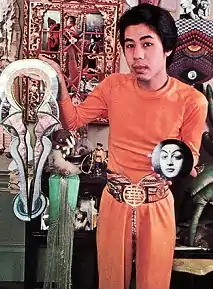Kaisik Wong
Kaisik Wong (1950 – 1990) was a Chinese-American fashion designer. He emerged from San Francisco wearable art movement in the early 1970s and was active until his death from leukemia in 1990. Wong created avant-garde garments for celebrities such as Salvador Dalí, Anjelica Huston, Elton John, and Tina Turner. His clothing was sold at Henri Bendel, I. Magnin, and Obiko. He is known for his patchwork vest, which was the inspiration for Balenciaga's Spring/Summer 2002 collection.
Kaisik Wong | |
|---|---|
 | |
| Born | 1950 |
| Died | 1990 |
| Nationality | American |
| Occupation | Fashion designer |
Life and career
Wong was born and raised in San Francisco's Chinatown neighborhood. His father was an accountant and his mother a homemaker from New Orleans.[1] By the age of 14, Wong was silk-screening fabrics and making his own clothes, shoes, and accessories. At the urging of his art teacher, Wong dropped out of high school at 15 and studied at the Pacific Fashion Institute in San Francisco.[1]
At 17 years old, Wong moved to New York where he worked with designer Adele Simpson in 1967.[1] He traveled to Paris where he met Salvador Dalí, Yves Saint Laurent, Thierry Mugler, and Pierre Cardin.[1] He turned down a position to work for Cardin.[1] In the early 1970s, Wong returned to San Francisco to launch his own fashion label, Muuntux, which was sold in his own boutique until 1973. He made stage costumes for Tina Turner and Elton John.[2] Funk singer Betty Davis wore one of his creations on the cover of her 1974 album They Say I'm Different.[2]
Wong collaborated with filmmaker Steven F. Arnold, protégé of Salvador Dalí, to create costumed for the Cockettes.[3] This led to collaborations with Dali himself. Wong created costumes for Dali and exhibited his creations at the opening of Dalí Theatre and Museum in Figueras, Spain in 1974.[4] Wong often appeared in public dressed in full costume as a mythological Chinese trickster called the Monkey King, a role he played for Dali.[2][1]
Wong's aesthetic was described as "bridging a prevalent gap between the hippie movement and an era of glam-rock."[1] His designs were often inspired by ancient civilizations, incorporating kimonos, tunics, tapestries, and the embroideries and appliques of South America and Asia.[1] He also fused futurism with mythic themes. His garments were entirely handmade without any use of patterns.[5] His partner Jesus Santiago also designed with him.[6] 1978 interview for New York Magazine, Kwon quotes Wong’s own words that his clothing served a purpose: “The idea is to get people together and get them in touch with the changing of the seasons. The clothes in the collection are merely functional versions of what we do in the theater.”
Wong worked for the San Francisco art-to-wear boutique Obiko, owned and operated by Sandra Sakata where he made one-of-a-kind pieces. In 1977, he created a ready-to-wear collection under the Pitash Rhok label that was available at I. Magnin.[7] He also produced garments for Henri Bendel.[1] Wong designed the costumes for the 1981 film Fruits of Passion, directed by Shūji Terayama and starring Klaus Kinski.[8]
Wong, who was HIV positive, died of leukemia in at age 40 in 1990.[9][1] He is buried at Holy Cross Catholic Cemetery in Colma, California.
From December 1995 to March 1996, the exhibit True Couture: The Wearable Art of Kasik Wong was on display at the M.H. de Young Memorial Museum in San Francisco.[4]
In 2002, Balenciaga designer Nicolas Ghesquière was forced to admit he copied a design from Wong for his Spring/Summer 2002 collection.[9][10] The design was a 1973 patchwork vest that appeared in a 1974 reference book Native Funk & Flash.[6] "I'm very flattered that people are looking at my sources of inspiration. This is how I work. I've always said I'm looking at vintage clothes." Ghesquière said.[10] After the controversy, Cameron Silver's vintage boutique Decades on Melrose Avenue in Los Angeles celebrated the work of Wong. Silver assembled Live the Fantasy, a retrospective exhibit and sale of pieces from the Wong family collection.[3] The patchwork vest was the only garment not for sale, it was later included in the exhibition Iconic to Ironic: Fashioning California Identity at the Oakland Museum of California.[1]
References
- Moore, Booth (December 16, 2002). "Still dazzling". Los Angeles Times.
- "10 — Pride is a Protest". prideisaprotest.com. Retrieved January 6, 2021.
- "Decades Celebrates the Vest of Wong". WWD. November 27, 2002. Retrieved January 6, 2021.
- Donnalley, Trish (December 21, 1995). "Kasik's Art Wears Well / Unique talent of late artist on view in De Young exhibit". San Francisco Chronicle.
- University, © Stanford; Stanford; California 94305 (June 24, 2020). "Kaisik Wong's Radiant Skins". The Clayman Institute for Gender Research. Retrieved January 7, 2021.
- Hart, Alexandra Jacopetti (2013). Native Funk & Flash: An Emerging Folk Art. pp. 60–63. ISBN 978-1-4669-8172-0.
- Behbehani, Mandy (December 28, 1995). "Wong's Art of Clothing". San Francisco Chronical.
- Gerber, Jacques (1989). Anatole Dauman: Argos Films : souvenir-écran (in French). Centre Georges Pompidou. p. 321. ISBN 978-2-85850-522-7.
- Horyn, Cathy (April 9, 2002). "Is Copying Really a Part of the Creative Process?". The New York Times. ISSN 0362-4331. Retrieved January 6, 2021.
- "Balenciaga Spring 2002 Ready-to-Wear Collection". Vogue. Retrieved January 6, 2021.